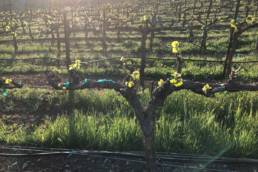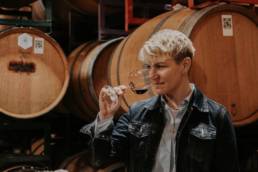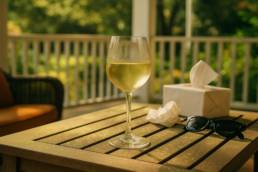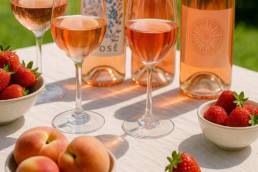FMN – January 2022 – A Better New Year, With Wine
With the New Year fresh in the rearview mirror, we look to the promise of a better year ahead. That credence of “better” does not emerge by accident. Rather we need to aspire and work toward making this next year the best it can be. Don’t worry, I’m not converting to an inspirational speaker nor are you in danger of me whispering Nietzsche quotes. I am, however, passionate about taking the proverbial bull by the horns (or bottles by their necks) and dedicating this next year to “sucking the marrow out of life.”
So how do we balance our inner id, demanding we fulfill our need for pleasure, while attempting to climb another rung on the ladder toward self-actualization? Simply, we drink. Our consumption must not, however, be with mindless disregard and Whitman-esque barbaric yawps of freedom. Instead, the corks are popping and glasses filling with the comprehensive purpose of greater understanding and broader cultural appreciation; one bottle at a time.
The first step is a relative short hop and not too far into obscurity. Overall, I thing Spanish whites are under rated and underappreciated. If you are familiar at all with the traditional method sparkler coming out of Spain known as Cava, then you have already consumed our first grape variety, Macabeo (ma-caw-bay-oh). It is also known as Viura in the Rioja region where it softens red Rioja wines and adds acidity to the wine blends. Although found heavily planted in northern Spain, where it most likely originated, the variety has also found a home in Roussillon, France. Unfortunately, many producers relegate it to a blending grape or over-crop it for Spanish “street wine.” It’s lack of popularity is to our benefit, keeping the cost in the bargain category.
The next variety boasts as being the oldest vitis vinifera grape in all of the Americas. Known as the Mission grape in California, the name stems from the fact that missionaries brought the grape to the New World mainly for the purpose of producing sacramental wine. Once widely planted under the names Criolla Chica in Argentina and País in Chile, recent studies have matched the DNA to the ancient Listán Prieto variety found in Castilla-La Mancha, Spain. Today this variety has been supplanted in California by more marketable varieties and the miniscule amount that remains is mostly used for a blending partner in fortified wines. Chile and Argentina still grow a large amount of this variety but sadly most is overcropped and relegated to jug wines. There are some producers that believe in this variety and pay respect to its historical significance by making good wine. It’s drought resistance and long-life span make it a potential revisit for the future ever changing viticultural climate.
Next on our journey is a destination rather than a selected variety. The island of Corsica, called “Ile de Beauté” by France, has been a viticultural haven for thousands of years. The Phoenicians, Romans, Greeks and the Genoese all made wine here. Although long overshadowed by the other French exports, this island has found it more difficult in recent time to fly under the proverbial radar.
Nielluccio (Sangiovese) and Sciaccarello (Mammolo) are their most planted reds and Vermentino for white but there are a myriad of indigenous varieties that are scarcely found elsewhere. Over the last few decades, producers have taken steps to update technology and improve the winemaking. Like some of our other selections, Corsican wines are not a big demand item in American retail shops which means, when you find them, they prove to be drinking comfortably above their price point.
Our final variety is quite familiar but long misunderstood. It was originally known by the Croatian name Tribidrag (from Greek for early ripening), where it was already growing by the fifteenth Century. In subsequent records and even today we see it mentioned in Puglia, Italy as Primativo (from Latin for first to ripen). Domestically, and most notably in California, we call this variety Zinfandel. Unfortunately, it is in California that this variety has been mistreated either by the flood of white Zinfandel or the vapor-trail high alcohol and dried fruit elements (partially due to its characteristic of uneven ripening). Thanks to the efforts of groups like ZAP (Zinfandel Advocates & Producers) these wines have improved in quality and ageability; even if it remains alongside the “less noble” versions.
As we edge into the new year full of hope and slight trepidation, the waxing and waning of things to come can be smoothed out by a little wine in our gob. It being the post-holiday season, I practiced some wallet relief with all our selections; guaranteed to get you some change back from a “Jackson”. In the coming year work to improve your diverse appreciation of wines and remember that we can all justify our habits through education.
Suggested Wines:
Bodega la Remediadora La Villa Real Macabeo 2020 Castilla / La Mancha $10
One may recognize the grape Macabeo as one of the prominent varieties used in the Spanish traditional method sparkling wine, Cava. The nose is overt with orchard fruit (green apple, white peach), a touch of tropical citrus (tangerine), citrus pith, watermelon rind, and fresh cut green herbs. The palate is dry with up front, bright citric type acidity and a roundness to the body. The palate shows an increase in the citrus element (tangerine, blood orange) that lingers throughout a prolonged finish. This wine is drinking above it’s price range, but don’t tell them. A great porch sipper, paired with lighter fish dishes or to accompany creamy cheeses.
Garage Wine Co. País-Cariñena 2020 Phoenix Ferment Secano Interior Cauquenes, Chile $18.99
The white wine is made from two red grapes: 86 % País from two farms Truquilemu and Sauzal, and 14% Cariñena from Purapel. The nose has an interesting blend of aromatics: ripe tropical (plantain), citrus (lime and lime blossom), white plum, and herbs (marjoram / tarragon). The dry palate has a tart acidity, a medium body and a very slight perception of tannin on the cheeks. There are flavors of citrus (lime), white cherry, and barely ripe white plum. The finish is long with citrus and a nut-skin element. This sturdy white would love brined pork chop, game birds (quail), lighter meats (mortadella). With only 2604 bottles produced, this is an interesting and special find.
Domaine Petroni 2016 Vine de Corse Rouge Corsica $15.99
On the shores of Lake Diana, this vineyard had been producing wines since 1885. Our wine, the rouge, consists of 50% Nielluccio (Corsican clone of Sangiovese), 35% Syrah, 15% Grenache. The nose has over ripe black fruit (blackberry, currant), dark plum, fig, woody herbs, and tertiaries of pencil graphite. The palate is dry, medium bodied, broad crechendowing acidity. The tannins are integrated, sandy and ripe. The palate mirrors the nose with black fruit and dried herbs and an enhanced minerality. Pair with pizza, slow roasted meat, or bolognese.
Hobo Camp Wine Company Zinfandel 2017 Sonoma $17.99
Sourced from select growers in Sonoma AVA, this 91% Zinfandel and 9% Petite Sirah offers a pleasant relief from other California Zins. The nose has some restraint with aromas of red berry fruit sauce (raspberry, cherry) and baking spices (clove, nutmeg). The palate is dry with refreshing acidity, medium body, well balanced alcohol, and evident but low-astringent tannins felt all over the mouth. The flavors are relievedly non-jammy but rather crunchy and vibrant red fruit, baking spice and a hint of sweet tobacco note. The strength in this wine is in the fact that it is not over ripe, over extracted nor jammy, the way many California Zins are today. Well done. Pair with lighter pork dishes, cured salty meats, and an unseasonably warm January day.




